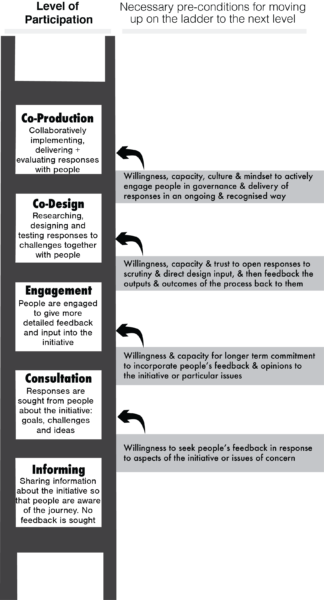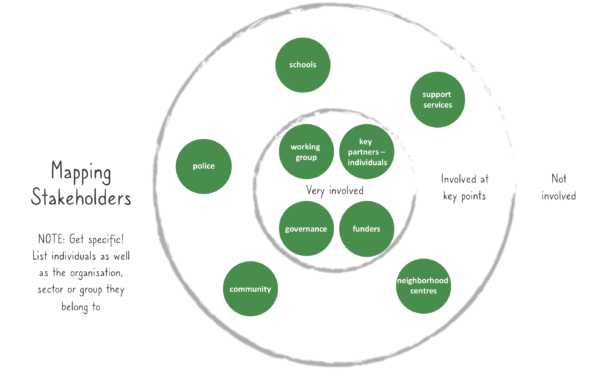Work in community is work done with others. Without broad and genuine buy-in, progress can stall. People from all parts of the community need to come along the journey. That includes those who we’re working to benefit along with people in support roles within and beyond our communities who will be a part of bringing about change.
To bring others along the journey, we need to be clear why we’re engaging people. This includes helping people to understand what is in it for them, and how their participation contributes to the broad goal we’re working towards. This goes beyond delivering information. We’re striving to create genuine and meaningful opportunities for contribution.
The ideas and stories captured here were shared by members of the Regional Innovator’s Network (RIN) during a peer learning session on 24 July 2018.
Quick summary
What does it mean? (guiding questions)
- Why are you engaging people? – How could bringing people along the journey support the ultimate goal of your project?
- Who should you involve? – Who are you expecting to be a part of the change you’re looking to see
- Why will people want to be involved? – Understanding what motivates people
- When will you involve others? – Engaging people and keeping people informed along the way depends on their role and level of contribution
- How will you involve others? – Choosing strategies for engaging people
- What will you share with them? – Determining the content people need in order to come along on the journey, be a part of the process and to contribute
- How will you support people? – How you help people contribute
What helps
- Considering how engagement can contribute to shifts in behaviours and mindsets
- Creating a stakeholder engagement plan
- Relationships
- Taking every opportunity to tell the story and invite people in
- Honesty and transparency
- Turning a negative into an opportunity
- Giving people a good way out
What hinders
- Just doing it yourself
- When new people come onboard – rough transitions
What does it mean?
The following series of guiding questions are prompts for your thinking on how to bring people along the journey.
Why are you engaging people? – How could bringing people along the journey support the ultimate goal of your project?
The first step in bringing others along the journey is to take a step back: step back to zoom out and think about what you’re trying to achieve. What are your goals, what are the outcomes? What is the change you hope to catalyze? What behaviours are you looking to change? What do you hope will be different after this initiative?
Then think about why others need to be involved. What difference will it make if others are involved? How might they help support the goals…how are they vital to achieving the goals? What perspectives, gifts, skills and influences will be needed to think through your initiative and to help make things happen?
Who should you involve? – Who are you expecting to be a part of the change you’re looking to see?
Once you’ve considered why you need to involve others, the next step is to determine who to involve. This list of questions can be useful in determining who to involve.
- Voice of intent – e.g. decision-makers and sponsors
- Voice of lived experience – e.g. the service ’user’, young person, community member or beneficiary
- Voice of those ‘making it happen’ – e.g. those who have experience working toward the outcomes you’re seeking, who can help you think through your ideas and who can challenge you as well – service professionals, event organisers, key informants, external provocateurs
- Voice of design – e.g. the ‘messenger’, the person or team trying to create something new or solve the issue
- Do you need different voices for each phase? What roles will you need, and who might take on each of those roles? Do you need people who create the conditions, knit together different initiatives, or roll their sleeves up and participate in co-design? To think through different roles you may need, check out this card deck of roles. <LINK>
- Do you need voices beyond the community? E.g. service ‘head office’ or state government
Why will people want to be involved? – Understanding what motivates people
When you think about the work that you’re doing, and the people you want to involve, why will they join you? Why will they say yes? Why will they stick with it? Why will they see it through to the end? What motivates them?
Here are a few examples:
- Shared purpose – is there a shared purpose that is important enough to bring people together? It could be a pain point, a crisis, a goal to achieve, a vision of a future
- Relationships – people are motivated to support others and relationships that are important to them
- Connection and belonging – sometimes what motivates is simply a desire to do things that we enjoy with others, to connect with others and have that feeling of belonging
- Desire to contribute – one motivation is the need to put skills and gifts to use, to be valued, to be in their element
When will you involve others? – Engaging people and keeping people informed along the way depends on their role and level of contribution

Getting people involved at the right time can reduce challenges as you move forward. Consider how early you can bring people in – sometimes it’s earlier than you think! Lay out an appropriate schedule that matches the context (e.g. working at the speed of community), urgency and goals of the initiative. How frequently will you involve people, and for how long? What level of contribution do you expect? Do you need different people at different times and phases? When will their contribution finish?
“I think it’s a really good question: do you need [different] voices for each phase? Because just from my experience doing project work, there are different voices for each phase in the work I’ve done.” – Sharon Tomas, Dubbo community connector
Different stakeholders will contribute in different ways. What level of engagement will be most helpful in achieving the goals of your initiative? Consider the ‘ladder of participation’, shown here.
How will you involve others? – Choosing strategies for engaging people
Here are a handful of ideas for engaging people along the journey. There are many, many more! Share your ideas for engaging people in the comments section below.
- Use your point of difference to invite people in
- Create an interesting way to ‘onboard people’
- Where are you working – are you visible or hidden away?
- How can you find ways to DO together with community – e.g. insights, ideas, new actions
- Frequent walkthroughs of what you’re learning and the progress you’re making
- Peer-to-peer sharing
- Walking meetings
- Leveraging champions
- Film, photography, theatre, arts
- Find ways to make participation fun, active and social
- One-on-one catch ups – quality time
- Find a way to stay at the table when difficult situations or perspectives arise – turn a potential negative situation into a positive
Another way to think about strategies for engaging people is to consider who may need to learn together? As an example, if you’re trying to shift community mindsets around a particular issue like youth offending, it can be incredibly powerful to bring them together and for people to hear the stories and perspectives of young people. When groups of people find it hard to understand one another, how can you bring them together in constructive ways so that they can begin to see things differently, frame challenges together and contribute to solutions side by side?
What will you share with them? – Determining the content people need in order to come along on the journey, be a part of the process and to contribute
When you engage with people, consider:
- What do they need to know and understand?
- If you want them to contribute, what context and additional information is required?
- Will you be sharing a progress update, timing and schedules, actions, data, insights?
- How much will be shared — is it a lot of information to take in?
- What is the best way for people to take in the information you want to share?
“I would reflect upon when Growing Lachlan started and we had completed our survey and our data sets and done a lot of our analysis and then had to check back in with the community. The conversations were that invitational point about where we were looking for people to jump on board and we were checking in I guess as well — is this real, is this valid, does it matter? Did we get it right? We really wanted to know what the community had to say about that and let them decide where we went with that information from that point forward.” – Shane Phillips, Lake Cargelligo community connector
How will you support people? – How you help people contribute
Sometimes people need additional support or skills to be able to contribute. If you’ve asked someone to perform specific tasks or take on a role, if may be helpful to work side by side with them for a while. You may need to orient them, ‘show them the ropes’. You may also need to teach them how to do some tasks. If you’re not able to do this yourself, consider finding someone who can. Without support, sometimes people who want to participate cannot because they don’t understand or don’t know how. The risk is that people end up frustrated and at worst, disempowered, and they walk away. You’ll be in a worse position than when you started – and they will too.
If you’re seeking to support people through a co-design process, consider referring back to the Regional Innovator’s Network capabilities. Scan through the different mindsets, skillsets and processes. Where are people strong and where might you want to work with them to help them contribute?
What helps?
Considering how engagement can contribute to shifts in behaviours and mindsets
Through this initiative, what mindsets and behaviours are you looking to change and how will bringing people on the journey support that? Often as part of innovation and co-design there is a need to shift mindsets and behaviours. For instance, we often use co-design in order to reduce the extent to which we ‘do for’ others. As a specific example, services and governments have a history (sometimes unintended and usually backed by good intentions) of making decisions on behalf of users and of solving the system issue instead of addressing the user’s challenges. The co-design and innovation process is where we can begin to change these mindsets and behaviours. Therefore, when you consider why you are engaging people, look beyond the outcomes of the process (e.g. a new event or program) and consider how engaging people can help catalyse change.
Shifts that can occur through participation in co-design and innovation processes:
- Bringing voices to the forefront that are often missed or disregarded
- Creating awareness of behaviours that are having unintended consequences, although well-intended – especially when it comes to working with people who are often disenfranchised, at-risk or disadvantaged through processes – and seeing shifts in these behaviours
- Embedding knowledge about challenges and how to address them differently
- Creating an appetite for change
- Creating greater capability and capacity for change
- Empowerment of those who have been disempowered previously
Transparency and honesty – ‘naming the elephant in the room’
Being transparent, open and honest throughout the process will build trust. It will also keep people interested in how things unfold. It’s a critical factor in bringing people along the journey. There are a some key things that it’s important to be transparent about:
- Project purpose, goals, expectations (e.g what we can influence), sources of funding/support and project constraints. One reason this is important is to make it clear what space open for ideas and people don’t feel their ideas have been shut down if it’s just that you cannot act on the ideas they put forward
- What you are learning and the different perspectives that exist – so that people feel their voice has been heard
- What is done with the information and how the initiative progresses – so that people feel their input has been acted on and know why certain decisions have been made
- Outcomes and learning from the process – so that people can share in the successes and acknowledge what didn’t work. This also helps avoid the ‘black box’ of government or services where feedback is provided and no one ever knows what happened as a result.
In doing work in community, and particularly in doing co-design, you learn a lot. Sometimes what you learn can be challenging to listen to and absorb, difficult to share or hard for others to hear. That doesn’t diminish the importance of sharing that information — in fact it may mean that it’s even more important that it is shared. Sometimes you do have to ‘name the elephant in the room’. It just means that you will need to be thoughtful about how you approach sharing and engaging others with what you’ve learned.
If you are concerned about the risk of being honest and transparent, consider the risks of not fully disclosing. You will find that people will disengage quickly or be more sceptical and critical if they feel the honesty and transparency is not there. You may also lose trust over the long run. Being honest and transparent is risky, but the risks of not being honest and transparent are far greater.
Relationships
People are motivated to support others and relationships that are important to them. Sometimes someone will be willing to help you simply because of the relationship that exists and the desire to help you with something you’re doing. Relationships are, of course, a two way street – everyone involved finds value in them. Relationships range in shapes and sizes, and even people who are really just acquaintances can be incredibly helpful when the right opportunity comes along. Many of the discussions in the network come back to relationships – and the importance of nurturing relationships across community. Aside from the intrinsic value that relationships have for our lives and the health of our communities, you never know when you might need them, or when they might need you!
Taking an opportunity to tell the story and invite people in
Like a pinch of salt, a little bit of opportunism can go a long way. When people show curiosity about an initiative, taking the time to share with them and even invite them in can help knit people together around the work you’re doing, create interest and generate goodwill – even if they don’t join. And you never know if they might drop in at a later point. It is like a pinch of salt though, in that you don’t want too much. For the most part, it helps to remain focused and strategic around how you engage with people. When you know you’re focused, staying open to that chance opportunity keeps things in balance.
“I think it’s also about being a bit opportunistic and you just take every chance you get to talk your story or sell your story or invite people to join in, it’s that invitational process.” – Shane Phillips, Lake Cargelligo community connector
Spotting and nurturing champions and delivery partners early on
Bringing others along on the journey isn’t just about filling up our ‘bus’, but also about spotting who might be a driver into the future. If we offer genuine opportunities for partnership, beyond simply informing people – we often notice potential leaders emerge from unlikely places. When we’re looking to shift community attitudes and behaviours, it helps to find community leaders who can embed change more productively than professionals and services are often able to. In a similar way, if we’re looking to change professional practice or government decision making – it helps to look out for and nurture relevant champions throughout your project work. The social innovation process isn’t just about creating solutions, but also building the connections and leadership to implement and sustain solutions into the future.
Creating a stakeholder engagement plan
For some projects and initiatives it can help to get organised with your approach to engaging stakeholders. Here are a few steps to creating a stakeholder engagement plan:
- Identify your goals and what you’re trying to shift – see sections above (e.g. community attitudes, service provider behaviour)
- What activities will be a part of your process and how will you phase those activities? (e.g. discovery work, idea generation, testing)
- Therefore, who might need to be involved at each of the different stages?
- Identify who you would like to involve (see suggestions above)
- Create a map of stakeholders (see map below)
- Create a plan – make a schedule. This can help you be practical about how broad you go with stakeholders, and how often. Butchers paper and sticky notes are one way to start. If you need something more formal or portable, try using an excel spreadsheet. List each stakeholder in rows. In columns mark out your phases and dates. Then in each cell indicate what type of engagement you’ll need – e.g. one-on-one catch ups, events, interviews, workshops, etc.

Giving people a good way in and a good way to exit
When a group begins together on a journey with an initiative, consider what you may need for a kickoff and project initiation process. Think about all the aspects that you’ll need to get going, but also consider it like team bonding exercise. What is needed for people to be on the same page and work well together? What expectations do people have, what level of engagement can they commit to and what are they willing to commit to others in the process?
Sometimes people join an initiative after it’s underway. Taking the time to introduce someone to an initiative that is already up and running is time well spent. Provide that grounding and orientation in the purpose and need for the initiative, what has changed, what decisions have been made and where you’re up to now. If others have had any capability building support, it can help to offer that as well.
If you are working with people who have lived experience then you will need to take care and consideration in how they engage. People with lived experience are not like professionals who make commitments which then require management and accountability (especially when participating is part of someone’s remit and role). Here are a few considerations in working with people with lived experience:
- They are not always available, and may not be available during ‘normal work hours’
- They may not access to transport and travel may be difficult
- If they have experience of mental health issues, motivation, confidence and self-esteem may be a barrier to participation, or participation in the way that others participate
- They may have a hard time being put on the spot and may need to leave a session without telling anyone; it may be helpful if they can give their feedback to someone individually or even outside the project team if they’d like to
- They may experience research fatigue
Not everyone will be involved in your project all the way through. As we’ve mentioned, sometimes different voices are needed at different times, but we don’t want to lose anyone along the way. When someone dips in and dips out, they may appreciate an acknowledgement of their contribution, closure with respect to their involvement as well as the option to hear about progress down the track. If a person is leaving, find ways to acknowledge their contribution, offer a chance to give feedback, and give them the option to brief the person who is taking their place (if that is the case). Being conscientious about when people exit ensures people feel valued and appreciated, and is also part of nurturing relationships.
“But what I’ve learnt is that we don’t always give people a way to exit well, and so I think if we recognise that a little bit more in our planning, do we need voices for each phase, and then helping people to be able to exit well rather than lose interest. I just think that’s is a really pivotal question and the benefits of that later on in the project are huge if you actually acknowledge that question in the beginning.” – Sharon Tomas, Dubbo community connector
What hinders?
Unclear invitations
Whilst it is important to invite a broad range of people to join, if they show up and don’t understand why they are there it can be a frustrating and disappointing experience. When you invite others in, step them through what you’re trying to achieve, their role, contribution and time commitment, benefits you expect to see, and what’s in it for them.
Failing to co-create with those who will be most affected by the change
Check your list of stakeholders. Does it include those who will be most affected by change? As an example, that means anyone delivering services that will change, but it also means those who are using that service. Have you found a way to engage people with lived experience, and have you enabled them to contribute to the solutions that in the end will be offered or provided to them? Have you tested with them, and do the ideas work for them? Going all the way through the process and then having solutions fall over because they don’t work for the people who are most affected is more common than you might think!
Going it alone
Addressing big and complex challenges is impossible alone. Avoid the frustration and the trap of doing it yourself — within reason. Sure, sometimes it makes sense to just do something yourself and that’s your role. But always keep an eye to the opportunity. When would bringing others along the journey make a difference?
With regional innovation and work with community, we are often trying to create sustainable change. Change that can be sustained is shared across a number of people – people who come from different points of view and levels of ability to contribute, including clear and strong leadership. To bring a diverse group along the journey, go slow — keep knitting.
“It is always the easy option to just do it and then say this is what we’ve done. But trying to get people to work with you so that you don’t feel like you’re isolated or solely there, it’s sort of trying to get people along on the journey is sometimes a challenging process.” – Annette Ohlsen, Condobolin community connector
Be on the lookout for ‘founders syndrome’ – when someone who has started an initiative clings to it so tightly that they cannot bring others along the journey and the initiative is suffocated as a result.
When new people come onboard – rough transitions
A shift in stakeholders is one of the most common risks to the success of a project in reaching its goal.
It’s natural to get attached to our plans, timeline and vision — and these are the things that tend to shift when a new stakeholder comes on board. Project teams may experience anxiety around a shift of stakeholders for this reason. It’s important to manage the concerns within the team and to acknowledge that a person who comes on board will have their own concerns. Particularly if the stakeholder has a significant amount of influence and/or say in decision-making, is worthwhile to slow down, regroup and negotiate expectations because projects can grind to a halt altogether if key stakeholders are not on board.
At the same time, is also important that new stakeholders understand the origin of the project and are connected to the voices that have helped to shape it. Whilst they will have their own expectation, this will need to be moderated by respect for the expectations surrounding the initiative and the progress and momentum that has already been built. What strategies might you put into play in order to support new stakeholders to understand the expectations of community (including focus, pace, investment)? How might you support them to immerse in the learning to-date, ideally with those who have been a part of creating the insight.
Anyone that comes onboard to an initiative will need time to get up to speed. Relaxing expectations around timelines can alleviate some of the concerns they may have, as does an offer to spend time immersing in the background and current work. Spending time with the new stakeholder, walking them through the process and how you arrived at key decisions will provide important context. Get to know their background and perspective to understand how the project may benefit from their insight and experience. Finding opportunities to support the new stakeholder with capability building, for instance around co-design and innovation, will also help level the playing field, for instance if a team is in the middle of a co-design project.
Frameworks
- Identifying and mapping stakeholders
- Ladder of Participation – to determine what level of engagement is needed
- Role cards – a deck of cards to help you identify what roles are needed throughout an initiative
Related capabilities
- Staying grounded in and connected to community and place: Whatever you are doing, how you’re doing it, and what you deliver has to be right for your community and the place
- Doing with not for others: When we are working to bring others along the journey, we may be trying to avoid “doing TO others” and it takes a shift in mindset
- Catalysing change through the right partnerships: Sometimes it takes a strong partnership to make something happen
Do you have any examples of helpful strategies for engaging stakeholders? Share them in the comments section below!



